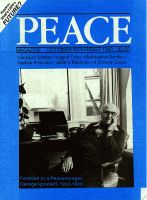
Peace Magazine Oct-Nov 1989, page 12. Some rights reserved.
Search for other articles by Dean Babst here
That nuclear weapons contain radioactive materials is well known. What is not generally known is that the use of a few modern nuclear weapons can produce vast global radioactive fallout. In 1947, Dr. Edward Teller's group at Los Alamos concluded that 100 huge nuclear bombs could raise the planet's radioactivity to "a dangerous high level." [1]
The more nuclear weapons a nation uses, the more global radioactive fallout will be produced and the greater will be that nation's own Self-Assured Destruction (SAD). This is equally true whether the nuclear weapons are used intentionally or through misunderstanding, miscalculation, or accident.
The Mutual Assured Destruction (MAD) defence strategy is becoming a SAD possibility. For example, if just one Trident submarine launched its missiles, it could release radioactive fallout equivalent to more than 300 Chernobyl accidents. This estimate is based on the submarine's carrying 192 warheads (24 missiles with 8 big warheads of 475 kt each).[2] In this estimate, to clearly illustrate the suicidal nature of nuclear weapons, it is assumed that the other side does not retaliate. Of course, if there is retaliation, the destruction will be vastly greater.
Can anyone imagine the destructive effect of global fallout from more than 300 Chernobyls? Consider the effects of just one Chernobyl. The worst nuclear power plant accident occurred April 26, 1986 when an explosion and fire split open an atomic reactor in the Soviet Ukraine, sending radioactive clouds upward to circle the globe.
That explosion left at least 27 nearby cities and villages too contaminated for people to live in, and 135,000 people had to be evacuated. [3] Two years after the disaster, beef and dairy products in Ireland, Denmark, Great Britain, Italy and the Netherlands were still contaminated. Sweden's annual reindeer kill (about 100,000 animals) had to be disposed of, since the meat was too dangerous to eat. Expectant mothers in the most contaminated areas were warned to follow strict diets.[4] Three years after the accident, 20 more villages in the Soviet Union are being evacuated.[5]
Nuclear weapons are truly suicidal, in that it is not known on whom the radioactivity will fall. The global distribution of radioactive fallout on any given day is greatly affected by shifting patterns of wind and rain. The Chernobyl radioactive cloud soared higher and faster than experts expected, drifting across Europe before mixing with the jet stream over Japan and speeding east. In the U.S., fallout from Chernobyl, as measured by increased radioactivity in air, milk and water, was greatest in Alaska, Washington, Oregon, California and Vermont. Death rates in these areas were significantly higher than the expected rates during the four months following Chernobyl.[6]
Much uncertainty must surround any estimate of the deaths from Chernobyl's radioactive fallout. Dr. Robert Gale has predicted that 3,000 to 30,000 people worldwide will die of cancer as a result of the accident.[7] Dr. Ernest Sternglass, who argues that low-level radiation may be far more dangerous than the orthodox model suggests, predicted "a minimum of 600,000 additional deaths" due to the accident.[8] Dr. John Gofman estimates that the Chernobyl accident will cause 500,000 cancer and leukemia deaths worldwide plus a variety of other illnesses.[9] All this is based only on radioactive fallout dangers. If other environmental dangers were taken into consideration, such as "nuclear winter" and loss of ozone, estimates of the peril would be much greater. Radioactive fallout dangers could be much greater than from nuclear weapons alone because there would be effects from nuclear power plants' radiation as well.[10]
Although one submarine could destroy the Soviet Union, the U.S. plans to build 19 more Trident II submarines that, with associated support, will cost $154 billion.[11] Are any of these funds being used to appraise the chances of self-destruction?
A report, Suicidal Defences: Radioactive Weapons, providing mathematical procedures for assessing self-destructiveness of weapon systems is available upon request from the Nuclear Age Peace Foundation, 1187 Coast Village Road, Suite 123, Santa Barbara, CA 93108.
Dean Babst is Coordinator of Accidental War Studies for the Nuclear Age Peace Foundation in California.
1 David Hawkins, Edith C.Truslow, and Ralph Smith, Project Y: The Los Alamos Story, LAMS-2532;Tomash, Los Angeles, 1983,p.187.
2 Dean Babst and Margo Schulter, Suicidal Defences: Radioactive Weapons, Global Security Study No. 5, Feb. 1989 Nuclear Age Peace Fndtn, Santa Barbara, CA.
3 Girard C. Steichen, "Chernobyl Still Haunts Europeans Two Years Later," Contra Costa Times, 24 April 1988.
4 Stephen Magagnini, "What We Now Know of Chernobyl's Toll," The Sacramento Bee, 27 April 1988.
5 Radiation Bulletin, March 1989.
6 Patricia LeFevere, "Statistics Indicate Chernobyl Disaster Effects in U.S.," National Catholic Register, 16 October 1987.
7 "New Cherbynol Death Estimates," The Sacramento Bee, 27 April 1988.
8 Ernest J. Sternglass, "The Implications of Chernobyl for Human Health," International Journal of Biosocial Research, Vol. 8(1): 7-36, 1986,p.33.
9 Keay Davidson, and Paul Freiberger, "Radiation: Risk & Reward," San Francisco Examiner, 12 April 1987.
10 Charles S. Shapiro, et. al. "Radioactive Fallout," in Solomon and Marston, eds.,Medical Implications of Nuclear War, Wash.D.C., National Academy, 1986.
11 U.S. Gen. Accounting Office, (GAO/NSIAD -- 89-40), Washington, D.C., Nov. 1988.

Peace Magazine Oct-Nov 1989, page 12. Some rights reserved.
Search for other articles by Dean Babst here